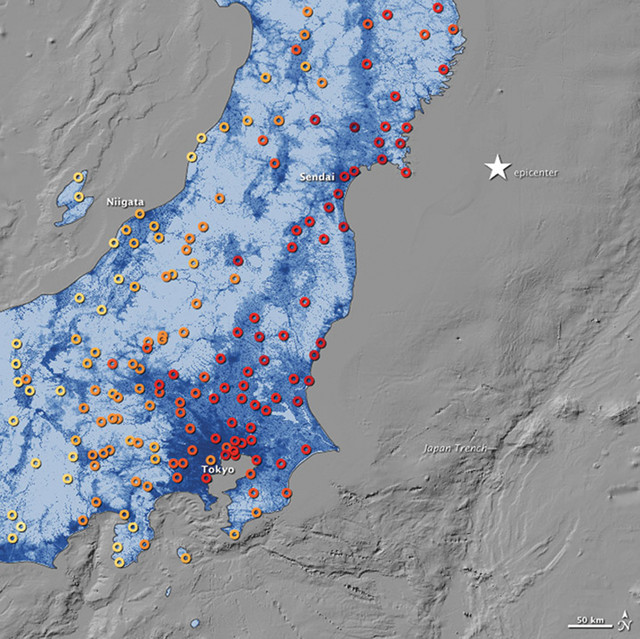
by Julia Rosen Monday, April 20, 2015

Shaking intensities (based on USGS data) on Honshu Island during the 2011 Tohoku earthquake in Japan. Warmer colors indicate greater intensity. Credit: NASA Earth Observatory Image by Jesse Allen and Robert Simmon.
Everyone notices when a fault ruptures quickly — the ground shakes and shudders, and sometimes, the seas churn. However, tectonic plates can also creep past each other so slowly that it’s almost imperceptible. Researchers say they’ve now identified the longest example to date of this type of movement along the Japan Trench in the decade leading up to the devastating magnitude-9.0 earthquake that shook the island of Honshu in 2011.
Scientists first noticed that the continental crust of Japan had deformed in a curious pattern while analyzing historical data from a network of GPS stations in the Tohoku region following the quake. These stations document Honshu’s slow westward migration, driven by the momentum of the Pacific Plate plowing under it. But after removing the effects of smaller earthquakes, which allowed the island to temporarily hold its ground, the researchers found that some GPS stations in the northern part of Tohoku moved at different rates from those in the south.
“We think the plates were actually slipping very slowly over nine years” in parts of the trench adjacent to the slowest-moving parts of Tohoku, says Kazuki Koketsu, a seismologist at the University of Tokyo and an author of the study, published in Nature Communications. In total, the researchers estimated that this slow slip accommodated as much plate motion as a magnitude-7.7 earthquake. Meanwhile, the northern part of the trench remained stuck, pushing that part of the island westward at a faster rate.
However, slow slip isn’t quite as simple as it may sound. It’s not that an entire plate boundary slides smoothly; rather, it happens at intermediate depths in a fault — from about 30 to 60 kilometers below the surface — between where the interface is rigid and locked and where the pressure and temperature are so high that the plates move continuously. Slow slip occurs when this transitional part of the plate boundary becomes unstuck, permitting more fault movement. Although scientists don’t completely understand why it happens, they can recognize when it does because it creates a pattern of deformation that can’t be explained by other mechanisms, like earthquakes.
Following an earthquake, a fault will often continue to move, says Andreas Mavrommatis, a seismologist at Stanford University who was not involved in the work. But this movement gradually slows down, “until it vanishes,” he says. In contrast, during slow-slip events, fault motion can persist over long periods of time, and can even accelerate, although not to the point of producing an earthquake.
Coincidentally, the change in fault movement in Japan seems to have begun in 2002, right around the time that seismologists first recognized the phenomenon of slow slip. Since then, they have identified its influence on the central San Andreas Fault, the Cocos Plate Subduction Zone, and the Cascadia Subduction Zone, which experiences recurring episodes of slow slip for about two weeks every 14 months.
However, there has never been an event of this duration before, as far as anyone knows, Koketsu says. In a paper published in Geophysical Research Letters in 2014, Mavrommatis and colleagues independently found similar evidence of slow slip in the Japan Trench using the same GPS data but a different method of correcting for past earthquakes. Based on that analysis, Mavrommatis thinks the slip may have started before 2002, perhaps even before the GPS network was established in 1996.
Koketsu’s team suggests that, instead of relieving stress and lessening the likelihood of a major earthquake, sustained slow slip may have actually contributed to the 2011 Tohoku quake. Although Mavrommatis and his coauthors didn’t address this question in their study, he says it’s possible. “When you have slip on a fault, that slip will release stress, right? It turns out it releases stress only on the part of the fault that slipped — it actually increases the stress on adjacent parts of the fault,” Mavrommatis says.
In the new paper, the authors used a model to take this one step further, arguing that slow-slip events may actually constitute a fundamental component of the earthquake cycle that occurs in subduction zones. Evelyn Roeloffs, a seismologist at the U.S. Geological Survey, says it’s plausible, but hard to confirm.
Many slow-slip events happen without producing big earthquakes, she says. “They can just be business as usual.” On the other hand, there is some “sketchy evidence” from before the collection of data by GPS networks — for instance, from trends in tide gauge records that can’t be explained by oceanographic processes — that suggests some slow-slip events did culminate in large earthquakes.
Overall, she says, “it makes a lot of sense that, before something fails catastrophically, it often gives a little indication.” The problem — if you can call it that — is that there simply haven’t been enough big quakes in recorded history to tell.
© 2008-2021. All rights reserved. Any copying, redistribution or retransmission of any of the contents of this service without the expressed written permission of the American Geosciences Institute is expressly prohibited. Click here for all copyright requests.